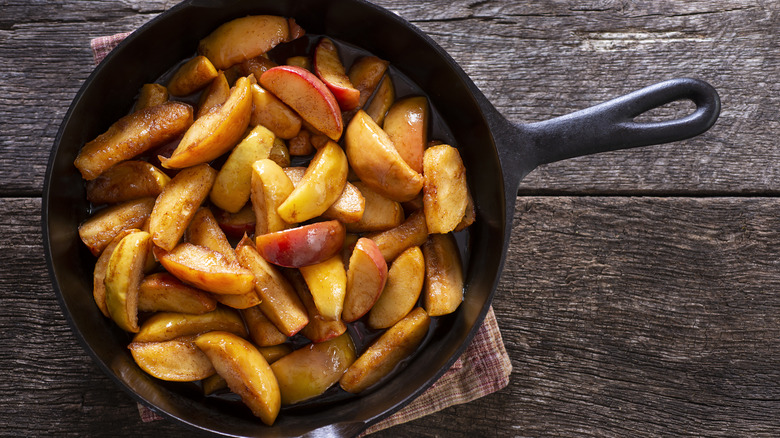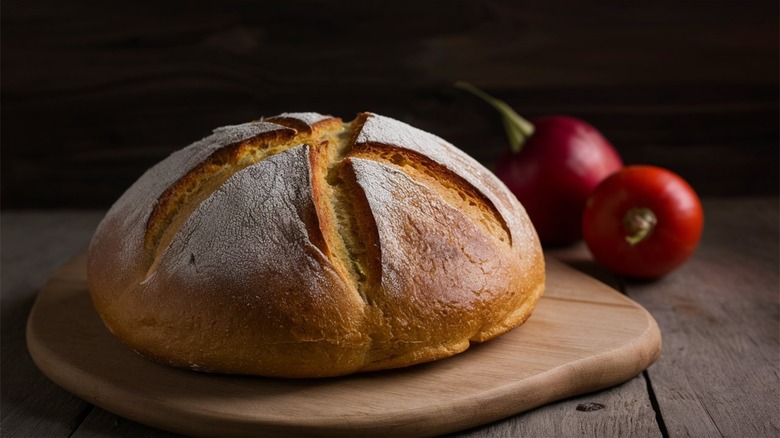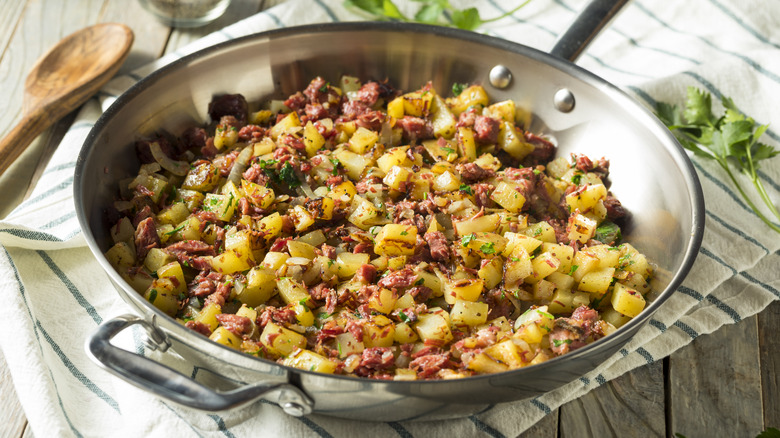5 Regional Specialties You Should Try For A New England Breakfast
The U.S. is a big, sprawling nation where different regions developed their own food traditions over time. Some traditions have become more widespread than others. If you're anywhere in the U.S. there's a chance you've tried Southern comfort foods such as biscuits and gravy or Brunswick stew that are known and loved throughout the country — and perhaps even the world. However, other regions have also made their mark on the American culinary landscape. For instance, take New England, which boasts a variety of breakfast dishes that people have enjoyed for ages. They include recipes made with unexpected ingredients or that take food traditionally served at dinner time and add them to the morning meal.
While it's impossible to encapsulate an entire region's traditional foods in just a few selections, many of the breakfast foods we're presenting here do have roots spanning back many years and possibly even pre-date the founding of the country. Rye pancakes, sauteed apples, anadama toast, corned beef hash, and fish cakes are just a few dishes that carry on the grand and flavorful New England breakfast tradition.
Rye pancakes
Pancakes are a staple of many homemade breakfasts, but people do things a little differently in New England. In this case, rye flour may be used in place of wheat flour when making them. They may also be flavored with ingredients like rum and molasses. This tradition dates back to the 18th century, a time when rye flour was far more abundant than wheat in the New England region. Most often associated with bread, rye flour gives foods a tangy, somewhat nutty flavor. As a result, pancakes will have a richer, more complex taste than one would get from the typical wheat-based version.
Rye pancakes are also denser than ones made from wheat flour. This can be explained by rye flour's lower concentration of glutenin, a protein that facilitates stronger gluten bonds. Robust gluten bonds create a lighter, bouncier texture, which means rye pancakes often have a chewy quality that's absent in fluffy wheat-based pancakes.
Sauteed apples
One can easily see how spiced, sauteed apples would be a welcome addition to just about any breakfast spread. This dish is essentially what you would find at the center of a warm, satisfying pie, but instead, sauteed apples are a popular breakfast side dish in New England. They also make a great accompaniment to rye pancakes, as their subtle sweetness won't overwhelm the more nuanced flavor of the pancakes like ultra-sugary syrup might.
With this recipe, tart apples are usually the first choice, so Granny Smiths are a go-to. This apple variety imparts a refreshing, somewhat citrusy flavor that is elevated by warm spices like ginger, cloves, and allspice. Brown sugar and vanilla lend a bit of sweetness to the dish, while frying the spiced apples in butter helps them achieve the perfect caramelization. This simple yet satisfying creation is ideal for fall mornings when there's a chill in the air.
Anadama toast
What breakfast table would be complete without a side of buttery toast? In New England, anadama bread, which includes molasses and cornmeal, makes the perfect toast, thanks to its denseness. The molasses adds a minor caramelly sweetness, making this a more interesting selection than your standard white loaf. The origins of anadama bread are a bit tough to pin down, much like many other recipes. The name of the bread was first printed in 1915, although it's quite possible that the recipe predates that period.
As for the curious name, a popular tale blames a fisherman's frustration with his wife's lack of culinary skills. As the story goes, he attempted to remedy one of her botched creations (which contained molasses and cornmeal) by incorporating flour and yeast. The put-upon man was said to have exclaimed, "Anna, damn her!" While this mildly sexist origin story may not be as charming today, the appealing bread remains a favorite in New England.
Corned beef hash
If you're anything like us, you've spent at least a few moments of your life pondering corned beef hash. How do you "corn" beef? And what exactly is hash? Corned beef hash features a mixture of onions, potatoes, and corned beef, which is made by curing the meat with salt. Salt curing was a popular preservation method before refrigeration because it reduces moisture and prevents bacteria from growing. When it comes to this process, the term "corn" is not referring to the vegetable of the same name. Instead, it describes the large chunks of salt that looked somewhat similar to kernels.
Corned beef hash became a traditional New England breakfast food out of necessity. In the morning, remaining items from the previous night's dinner would be chopped up (or "hashed") and added to a skillet to create a hearty breakfast. In addition to providing fuel for the long day ahead, corned beef hash also prevented food waste. This was crucial when people were responsible for growing and processing all their own food.
Fish cakes
New England's proximity to fresh seafood probably has something to do with the region's love of fish cakes. This dish is known for having a delectably flaky texture. Using white fish, like cod or haddock, is key to creating a softer interior to contrast the crispiness of the breaded outer layer.
While recipes can vary, fish cakes typically feature some variation of white fish, eggs (which help bind the ingredients), breadcrumbs, mayonnaise, and seasoning. Some versions also call for potatoes, which make for a heartier dish. They may even include some type of cheese such as cheddar. If you're seeking a nice accompaniment, our easy tartar sauce recipe is the way to go, as it provides a tanginess that nicely complements the richness of the fried fish cake.
New England is steeped in a rich culinary culture that reflect its history and traditions. These regional dishes put an emphasis on hearty, fulfilling morning meals, so why not add a bit of Northeastern flair to your next breakfast?





